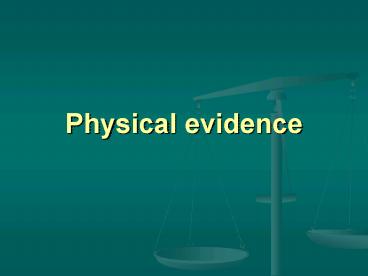Physical evidence
1 / 19
Title: Physical evidence
1
Physical evidence
2
Types of physical evidence
- Biological fluids
- Blood, semen, saliva
- Documents
- Drugs
- Explosives
- Fibers
- Fingerprints
- Firearms and ammunition
- Glass
- Hair
- Impressions
- Paint
- Accelerants
- Man-made polymeric
- Soil, vegetative matter
- Tool marks
- Powder Residues
3
Comparison
- A comparison analysis subjects a suspect specimen
and a standard/reference specimen to the same
tests and examinations for the ultimate purpose
of determining whether or not they have a common
origin. - Only tells probability of a common source
4
Individual vs. Class characteristics
- Evidence which is unique and has a high
probability of coming from the same source as a
comparison standard has individual
characteristics. Example DNA, fingerprints - Evidence which has some characteristics which
make it somewhat likely that it came from the
same source as a comparison sample possess class
characteristics. - Examples paint color, fiber type, hair, blood
type
5
Product rule
- Probability of finding a number of different
pieces of evidence with class characteristics is
determined by multiplying individual
probabilities - Williams trial
- Home carpet 1 in 7,792
- Car carpet 1 in 3,828
- Odds of finding two fibers at random 1 in 29
million
6
Individualizing evidence
- Even evidence which has class characteristics can
be individualized by additional factors. - Piece of tape was torn from roll found in
suspects vehicle
7
Properties of samples
- Physical properties
- Describe a substance without reference to any
other substance - Weight, volume, color, bp, mp
- Intensive properties dont depend on sample size
density, bp, mp - Chemical properties
- Describes the behavior of a substance when it
reacts or combines with another substance - In the presence of Heroin, the Marquis reagent
turns purple
8
Properties used to analyze glass samples
- Density weight per unit volume
- Refractive index velocity of light in vacuum/
velocity of light in medium - Edge thickness
- Lamination, tempering, etc.
- Chemical composition is not used
9
Determining density of glass sample
- Archimedess principle
- An object immersed in a fluid is buoyed up by a
force equal to the weight of the displaced fluid. - Water has a density of 1 g/cm3 or 1 g/mL
- Therefore a 2.5 g piece of glass with a volume of
1mL will weigh only 1.5 g in water - Density mass of sample/volume of sample
10
Comparing density by flotation column
- Place some bromoform (CHBr3, d2.89) in a test
tube. Add glass fragment and bromobenzene
(C6H5Br, d1.52) until fragment is suspended. - Add known glass fragment and observe whether it
floats, sinks or is suspended with other glass
fragment. - Both fragments suspended would indicated that
both had same density.
11
Refractive index
- A measure of the bending of a ray of light as it
passes from air into a solid or liquid. - Tempered glass will change its refractive index
as it is annealled (slowly heated and cooled) - Immersion method
- Silicone oil with fragment is heated until Becke
line disappears.
12
(No Transcript)
13
GRIM 2
- Instrument (Glass Refractive Index Measurement)
- Automated determination of RI
- Uses immersion method and analyzes video of glass
fragment as temperature is altered to determine
when Becke line disappears. - Can determine RI to 0.0002
14
Glass fractures
- Fracture patterns can be used to determine
- Whether glass was broken from outside or inside
- Size of object which pierced glass
- Velocity of object which pierced glass
15
Radial vs. concentric fractures
- 3R rule
- Radial cracks form a Right angle on the Reverse
side of the force.
16
Soil evidence
- Soil composition differs in different areas and
also at different depths. - Soil samples can contain
- Minerals
- organic matter
- botanical matter
- Specific seed and spores
- man-made substances
- Dust from inside can also be identifiable
- Kitchen flour, spices
- Bathroom powder, make-up
17
Soil analysis
- Soil properties can be changed with amount of
moisture present so must first be dried - Soil color- observed by smear test
- Soil pH measured
- Microscopy
- Determine soil structure and presence of unusual
material - Minerals
- Particle size distribution
- Established by passing through series of nesting
sieves with decreasing nest size
18
Density Gradient Tubes
- Formed by layering liquids with decreasing
density - Most dense at bottom, least dense at top
- Produces distribution pattern which can be
compared to known sample
Courtyard College Gardens Sports Pitch Crime
Scene
19
Soil sedimentation rate
- Suspend soil sample in water and observe Visible
light absorbance over time - Graph absorbance values
- Two sample which have same sedimentation rate
graphs likely came from a common source - Soil is nearly impossible to individualize.






























![[PDF] Orthopedic Physical Assessment (Orthopedic Physical Assessment (Magee)) 6th Edition Full](https://s3.amazonaws.com/images.powershow.com/10084240.th0.jpg?_=20240723111)
